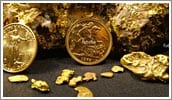
After three years of losses, gold prices rebounded in 2016. As a result physical gold demand dropped 20 percent, its lowest since 2009, according to GFMS analysts at Thomson Reuters.
What’s more, the gold market reached the biggest physical surplus of the century, at 1,176 tonnes, up from just 220 tonnes in 2015.
“Gold prices have started 2017 making up some of the losses from late last year. However, the US dollar is likely to remain a substantial headwind to further price rises, at least in the first half of 2017,” analysts said.
Buying of jewellery, coins and bars, plus official sector and industrial demand, fell to 3,349 tonnes last year from 4,184 tonnes in 2015.
The decrease in demand was largely driven by gains in the US dollar and a lack of buying from India, the world’s second top consumer, after Prime Minister Narendra Modi’s decision to abolish large Indian banknotes.
Gold prices are currently at $1,187.05, but GFMS analysts forecast gold prices averaging at $1,259 an ounce in 2017. However, not everyone is bullish on gold making strides in 2017. ABN Amro Group (AMS:ABN) suggested the gold price will fall to $1,100 an ounce by the end of next year, with a price recovery coming in 2018.
Top Consumers: India and China
In 2016, China became the largest consumer of the metal, but according to analysts this was not in anyway a reflection of strong demand there. In fact, jewellery demand in China, fell 15 percent in the last quarter of 2016 to 146.6 tonnes.
But what surprised analysts the most was India’s demand decrease due to political decisions, “Of all the dramatic twists and turns in 2016, Prime Minister Modi’s announcement was surely the most unexpected of all,” analysts said.
Modi is expecting that the move to abolish 500 and 1,00 rupee note would bring cash from the shadow economy into the mainstream,“We took the demonetisation decision not for some short-term windfall gain, but for a long term structural transformation,” he said.
Despite this, India’s gold demand slid to its lowest since 2003 at 580 tonnes, down by one third year-on-year. The country’s jewellery fabrication was also down, and hit a 20-year low in 2016.
Will Demand Rise in 2017?
Although physical gold demand hit a seven-year low, political uncertainty and tensions around the world, supported by the new Trump presidency, the UK leaving the European Union and upcoming elections in Europe, may rise gold demand later in the year.
“There are few indications that physical demand from Asia is set to pick up just yet. However, as the year progresses there is a growing likelihood of safehaven flows helped by either or both US and European geopolitics,” analysts commented.
GFMS analyst also note that from late December and until mid January, the jewellery fabrication industry should enjoy some respite, due to a relatively early Chinese New Year.
“With the upcoming Chinese New Year there is a seasonally strong period for jewellery and in India the shortage of cash has prompted some safe-haven buying from Indian consumers as source of wealth,” NAB analyst Vyanne Lai said.


































